For Dessert ... Olive oil ice cream with marinated melon and a traditional mojito
Friday, July 26, 2013

We are well into summer and cool refreshing desserts are on the menu, nothing like a great ice cream and some summer fruit so I thought I would share a really simple recipe for homemade ice cream with a twist.
Olive oil isn’t normally associated with desserts but it is gaining ground favourably with top chefs around the world and is appearing in more and more dishes every day. You won’t just find it on a salad dressing or drizzled over your grilled fish but now it is being used in sponge cakes and brownies and being poured over chocolate puddings, fresh fruit and flans, even olive oil jelly sweets are being offered, a recipe I will share with you in another post.
It might sound odd to some but at the end of the day the olive is a fruit and the oil is a juice and if harvested correctly will be bursting with fruity flavours, some greener and more herbaceous and others more tropical and sweeter, which tend to be the more favoured oils for desserts. The king of the dessert olive oil is with out a doubt the Arbequina variety, an oil which is not bitter, has very little pepper if any and is tremendously fruity with notes of apple and banana, I highly recommend you buy a very good extra virgin for this recipe as it is necessary to give it the full flavour: Abbae de Queilles, Basilippo or Castillo de Canena all offer fantastic 100% Arbequina olive oils and are available in most supermarkets amongst others.
This recipe ice cream made with olive oil and some of Spain’s most seasonal fruits, melon and lemon. A fantastic combination that isn’t too sweet but refreshing and different. Apart from adding antioxidants and vitamins as well as helping to boost your good cholesterol, olive oil also gives your ice cream a wonderfully unique smooth texture. Let’s say from a psychological point of view the goodness of the oil counteracts the badness of the sugar! It is well worth a go and I am sure you will impress any guest with this unusual but sophisticated dessert.
Ingredients:
Water
Brown Sugar
Lemon juice
Lemon zest
Lime zest
Extra Virgin Olive Oil
Large Egg Whites
Melon

The first step is to prepare some syrup. This is really easy and all you need is 300ml of water and 360 grams of white sugar. Pour the water into a pan and add the sugar, start to heat up the mixture and stir until the sugar has completely dissolved. When the mixture come to a boil add 15g of lemon zest and boil for 1 minute. Remove from the heat and let it cool down completely.
In a separate bowl you will need to add 3 large egg whites and whisk them together thoroughly, slowly add 240ml of Extra Virgin Olive Oil (Arbequina) as you are whisking , then add 300ml of freshly squeezed lemon juice (make sure you pass the lemon juice through a sieve first to remove the bits), continue blending the mixture until it is homogenous then add the mixture to the cooled down syrup and continue whisking until it is all evenly blended. All you have to do now is place it in the freezer until it is frozen.
The final step is to marinate the melon. Make sure you buy a ripe melon; you can tell if it’s ripe by pressing in on the melon at both ends with your thumbs. If you can push in the tips on the ends it is ripe for eating straight away. If they don’t budge its not ripe enough yet. Cut even slices from the melon of about 1 cm in thickness, then cut them up each slice into 3 pieces, remove all skin before hand. Place the melon slices in a deep dish. Take approximately 250ml of Arbequina Extra Virgin Olive Oil and add two tablespoons of sugar and 10g of lime zest., blend in the sugar and stir well. Pour the olive oil mixture over the melon pieces and leave in the fridge for at least an hour to marinate.
Finally when all is ready, serve the up the marinated melon with a ball of olive oil ice cream and decorate with a little lime or lemon zest. Lime gives a nicer contrast.
The great thing about this recipe is that you can substitute the lemon for any citrus fruits, be it oranges, limes, mandarins, grapefruit or any other, you could even make your own combination. By the way the syrup used in this recipe is the same syrup that is used in Cuban Mojitos (although it is sometimes done with brown cane sugar instead) so if you decide to make a little extra all you need to do is grab a bottle of white rum, some crushed ice, a lime and a little soda water. If your not sure how to make it here are the measurements for a large beer glass :
Add in this order to a cocktail shaker if you have one, if not just do it directly in the glass and stir well:
½ a fresh lime cut up into pieces (firmly roll the lime with the palm of your hand on the table top before cutting it up, this will help release the juices)
5/6 Spearmint leaves
Crush together in the glass with a pestle to release the lime juice.
Add 1oz Syrup (I prefer it with brown sugar)
Add 2 oz White Rum
Fill the glass to around ¾ full with crushed ice
Shake the mixture until it is completely blended / or stir vigorously in the glass.
Pour back into the glass and fill up the rest of the glass (or to taste) with soda water, dress with a slice of lime on the glass and a straw. A fantastic drink to finish the meal with.

Enjoy!
 0
Like
Published at 2:26 AM Comments (0)
0
Like
Published at 2:26 AM Comments (0)
Forget about the sharks - these little monsters are the real threat!
Wednesday, July 17, 2013
Last week it was sharks and this week local news has been warning the population of another troublesome tenant of the Mediterranean Sea. Scores of unsuspecting bathers, some of them young children, have already fallen prey to the small sea creature’s venomous sting. In Spain they call it the Pez Vibora – Viper Fish but it is commonly known in the UK as the Weever fish. This sly fish has sharp spines laced with venom along its dorsal fin which stick up out of the sand, where it hides while waiting for prey, and inflict agony on any unsuspecting bathers unlucky enough to tread on one. The sting is far more painful than any common jellyfish you may come across.
The nerve poison injected into victims brings excruciating pain lasting several hours, often causes people's limbs to swell and in extreme cases can lead to temporary paralysis. Irritation can last for two weeks.
Death is extremely rare following stings, although respiratory failure and gangrene have been reported after puncture wounds have become infected. It is considered one of the top ten most poisonous fish in the world, being nº 9 on the list!
The sandy-coloured fish, measuring around six inches, are more commonly found throughout the Mediterranean’s warm waters but are known be spreading around the British coastline too. They are usually invisible to the naked eye as they camouflage themselves under sand in shallow water. So at the end of the day it is potluck!
There are some basic precautions to avoid getting stung. The simplest is to wear some form of footwear in the water which is what all the local news channels have been recommending after there were a few cases this last weekend on Valencia’s coast. Another way is to shuffle your feet through the sand as you walk - this disturbance should scare away any nearby fish. Pain from an attack can last for up to 24 hours and those stung by the poisonous fish should treat the area with hot water.
Apparently if you do get stung the most effective treatment is to put the affected limb in water as hot as the victim can stand without causing scalding. The heat helps to break down the poison and it also increases blood flow to the sting causing natural cleaning and healing. The venom is a type of protein that is 'denatured' - broken down - at temperatures above 40C.
These little monsters bury themselves in the sand backwards for camouflage and snatch prey as it swims past. The venom is a nerve poison and has a chemical in it which is one of the most potent pain producing substances known.
The Weever's poisonous dorsal spine is a defence against potential attackers. Victims say that a sting feels at first like a sharp stab but the pain increases quickly. Weever fish are not strong swimmers but are capable of bursts of speed over very short distances. They use their excellent camouflage to lie in wait for prey to approach, when they suddenly dart out and engulf it in their relatively huge mouths although at most they could swallow your toe so I wouldn’t worry too much about their mouths but look out for spikes in the sand, as they particularly like shallow water!
Happy Bathing !
 0
Like
Published at 8:12 PM Comments (3)
0
Like
Published at 8:12 PM Comments (3)
The Spanish Bite Back!
Friday, July 12, 2013
Crunchy, full of protein and to be found under a rock near you. Insects have long been overlooked as food in all but a handful of places around the world – but now they are crawling closer and closer to our plates. 2014 will see a drive towards removing the yuck factor and putting insects not just on experimental gastronomic menus but also on supermarket shelves.
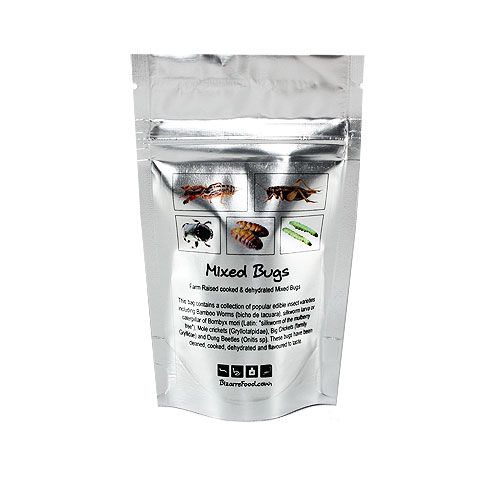
The Navarre Restaurant Merindad de Olite, run by Patxi Moliá and Lourdes Maíz, has brought out a new menu made from insects imported from countries like Thailand, Cambodia, Colombia and Australia. The new menú was presented to the public not so long ago. The presentation of the new list of dishes, which has received the name “ Tasty Bugs in Sauce” , explains the origin of insects that are used to flavour the exotic dishes and the possibility of breeding indigenous worms, grasshoppers, scorpions or spiders for food.
Patxi plans to develop three courses. The first will be a spicy winter soup seasoned with crickets, and the second will consist of a mixed wild rice with basmati from India and Thailand topped with roasted scorpions. To wrap up the menú there will be Lettuce Hearts stuffed with mustard, grasshoppers, crickets, barbecued worms and scorpion.
In Spain only two other hoteliers in Barcelona serve insects . "We must go beyond the border of prejudice" indicates Patxi. "We do not intend to change any habits or customs, but give an alternative, the entomofagia (insect eating).” Patxi defines the scorpion as the "pearl" of the menú: "Their venom is neutralised by contact with alcohol or very high temperatures”.
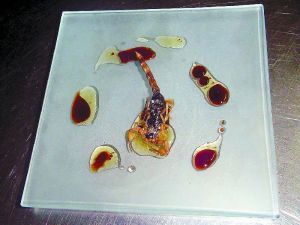
Somehow I think it will take a lot more creativity to get me to eat an insect! However it's estimated that the average human eats one pound (half a kilogram) of insects each year unintentionally! Cochineal insects give a red or pink coloring to foods, lipsticks, and beverages. The small, scaled bugs are listed as cochineal extract or E-120 on the ingredient list which is Carmonic Acid.
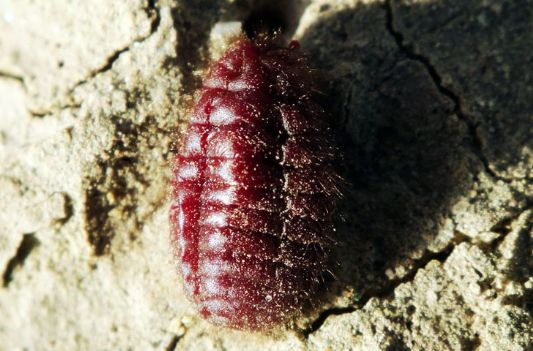 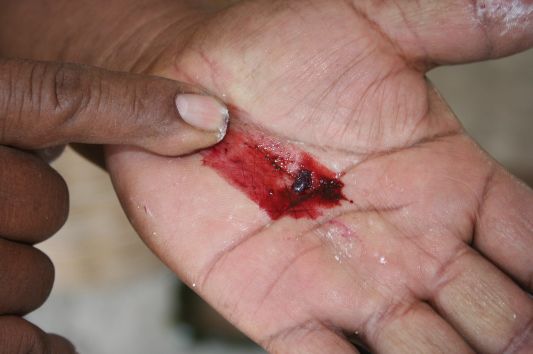
The U.S. Food and Drug Administration (FDA) also allows certain levels of natural or unavoidable defects in foods, as long as they doesn't pose a health risk. For example, chocolate can have up to 60 insect fragments per 100 grams, tomato sauce can contain 30 fly eggs per 100 grams, and peanut butter can have 30 insect fragments per 100 grams (3.5 ounces), according to the FDA.
the UN’s Food and Agriculture Organization (FAO) has been funding and encouraging projects since 2011 aimed at promoting the eating and farming of insects in south-east Asia and Africa, where an estimated two billion people already eat insects and caterpillar larvae as a regular part of their diet. In 2012, the FAO published a list of 1,909 edible species of insect and, with sponsorship from the Dutch government plans a major international conference on “this valuable food source” this year.
Insects are plentiful – globally, for every human there are 40 tons of insects – so there is not too much chance of them being endangered, and they are unlikely to have been dosed with chemicals. Over the next 30 years, the planet’s human population will increase to nine billion. Already one billion people do not get enough food. The increase will mean more pressure on agricultural land, water, forests, fisheries and biodiversity resources, as well as nutrients and energy supplies.
The cost of meat is rising, not just in terms of hard cash but also in terms of the amount of rainforest that is destroyed for grazing or to grow feedstuff for cattle. There is also the issue of methane excreted by cows. The livestock farming contribution, in terms of greenhouse gas emissions, is enormous – 35% of the planet’s methane, 65% of its nitrous oxide and 9% of the carbon dioxide.
Edible insects emit fewer gases, contain high-quality protein, vitamins and amino acids, and have a high food-conversion rate, needing a quarter of the food intake of sheep, and half of pigs and chickens, to produce the same amount of protein. They emit fewer greenhouse gases and less ammonia than cows and can be grown on organic waste. China is already successfully setting up huge maggot farms. Zimbabwe has a thriving Mapone caterpillar industry and Laos was given nearly $500,000 by the FAO to develop an insect-harvesting project. It’s already big business in the UK, though not always official: a man was recently detained by Gatwick customs as he stepped off a flight from Burkina Faso with 94 kilos of Mapone, worth nearly £40,000, in his luggage.
A study by FoodServiceWarehouse.com suggested that swapping pork and beef for crickets and locusts could help to reduce greenhouse gas emissions by as much as 95%. But perhaps the fairest thing about eating worms and insects comes when we are dead – then they get a chance to nibble their own back!
sources : National Geographic / ABC periodico / Guardian
 0
Like
Published at 1:27 PM Comments (1)
0
Like
Published at 1:27 PM Comments (1)
SHARKS ON SUNDAY!
Wednesday, July 10, 2013
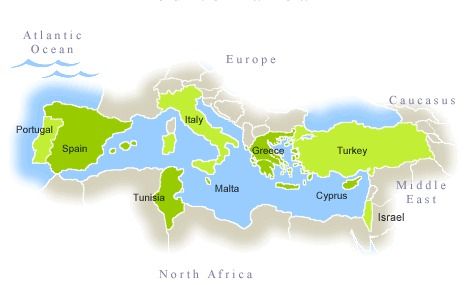
On Sunday we decided to go out for the day to the beach with the kids, every thing was running as usual but later in the afternoon just after having lunch and fighting with my mobile phone to try and follow the coverage of the Wimbledon final but to no avail we saw a speed boat racing up and down the beach. We were at Port Saplaya beach in Valencia and as there is a small marina there it wasn’t that unusual until we realised they were waving at the bathers ushering them out of the water, at the same time a couple of life guards were running along the shore calling all the bathers out of the sea. Immediately I looked for my 8 year old daughter who was wading along the shore and called to her, she too had noticed all the fuss and was incredibly intrigued by all the commotion. Within the space of about 15 minutes there was absolutely no one in the water, a very surreal sight this time of year. I figured it must have been a large bank of jellyfish that had been washed up with the tide but far from it, the guilty party was a school of sharks that had come into shore! I bet everyone’s thinking sharks? I thought the same thing! I knew there were sharks in the Mediterranean but the only time I have ever seen any was off the coast of Turkey, off the coast of Valencia the only threat I had ever come across in all my years in Spain were jellyfish so this was suddenly getting quite interesting and questions were arising what type of shark would they be and how big were they….
Now, I am not very knowledgeable on sharks and I could name probably about 5 or 6 different species of them and that’s about it so I was curious to find out more information. We went to talk to the life guard, who told us that a school of Tintorera Sharks had swum past their boat and were moving parallel to the shore. That name wasn’t in my list of five, but I had heard of it before even though I had never seen one, in English they are called Blue Sharks. Apparently they are quite common in the Mediterranean and potentially dangerous. He continued to tell us that they averaged 1,5m in length, which sounded pretty healthy to me so we decided to stay out of the water, by this time my daughter was really excited at the thought of spotting a real life shark and guess what every five minutes she spotted dorsal fins in the water, or what she thought or believed to be dorsal fins! Daddy did you see that? There’s another one! The way she reacted you would have thought it was a great white! I was thinking to myself, would I ever get her back in the water after this? Well not today I wouldn’t. However I was underestimating this species of Shark thinking it was just a big fish!
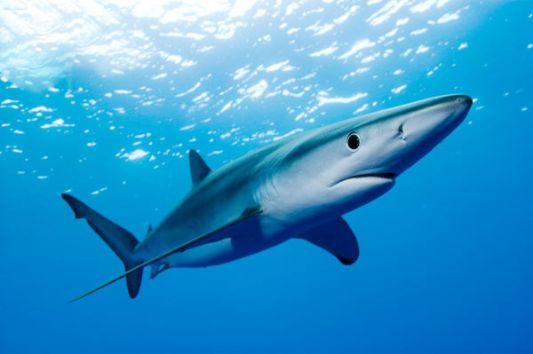
BLUE SHARK
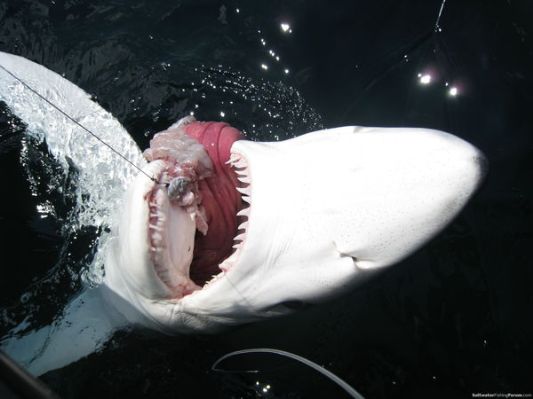
ADULT BLUE SHARK'S MOUTH!
The afternoon elapsed and we eventually went home without having stepped foot in the water since the alert, well that’s not entirely true, I tried to go for a quick dip in shallow water but my daughter nearly had a heart attack thinking I would be dragged out to see by some sea monster, so that mission was aborted abruptly.
When I got home I decided to investigate a little as sharks aren’t necessarily a species you associate with the Mediterranean Sea, dolphins yes, but sharks? I have never heard of a shark attack in the Med before, but given the climatic conditions and a plentiful food source, it should be thriving with them although they are never talked about. I discovered that the Med is in fact home to many sharks. Seldom seen, and even more seldom coming close to people, they are there, but in ever-decreasing numbers as they are being fished to extinction. The Mediterranean Sea is a huge sea spanning a massive 965.000 square miles, and its warm waters are home to at least 47 different species of shark, at least 15 of which could be dangerous to humans. That I didn’t know!
Yet despite millions of people using its 28,600 miles of coastline every year, there have been very few reported Mediterranean shark attacks, and fewer deaths.
Some of the waters in the Mediterranean reach a depth of over 15,000 feet although the average depth is just 4,000 feet. With very saline, warm waters and little tidal movement, the Mediterranean Sea is home to an abundance of sea creatures, giving the sharks plenty of food to live off.
In the straits of Gibraltar, the Mediterranean Sea opens into the vast Atlantic Ocean, and offers a migratory path for many open sea sharks to cross the ocean to the USA, which some species of sharks do unfailingly every year, returning to the deep waters of the Mediterranean to hatch their young as do the Bluefin Tuna from the North Atlantic.
Many sharks in the Mediterranean are virtually never seen and so pose no danger to water users, but their presence means that bathers and other users of water sports should always be on the lookout for them.
The three most dangerous sharks on the planet are believed to be present in the Mediterranean:
The Great white Shark (Carcharodon carcharias) - confirmed
The Tiger Shark (Galeocerdo cuvier) - though its presence has not been confirmed.
The Bull Shark ( Carcharhinus leucas) - again its presence is suspected but not confirmed.
However, there are many other dangerous sharks in the Mediterranean including:
Blacktip sharks (Carcharhinus limbatus)
Smooth Hammerhead Sharks (Sphyrna zygaena)
Scalloped Hammerhead Sharks (Sphyrna lewini)
Great Hammerhead Sharks (Sphyrna mokarran)
Short Fin Mako Sharks (Isurus oxyrinchus)
 Mako Shark Mako Shark
Grey nurse or sandtiger sharks (Carcharias taurus)
Sandbar Sharks (Carcharhinus plumbeus)
Spinner Sharks (Carcharhinus brevipinna)
Copper Sharks (Carcharhinus brachyurus)
Blue Sharks ( Prionace glauca ) – our newly made friends!
Sharp-nose Sevengill Sharks (Heptranchias perlo)
Oceanic Whitetip (Carcharhinus longimanus)
Only the big three mentioned above - the white, bull and tiger shark have teeth designed for tearing.

Great white caught in the Med
Other sharks' teeth are designed for gripping, and so are less likely to cause fatal wounds. Most sharks only bite humans to check out what they are. Great Whites are notorious for this, but because of their size, that one bite can be fatal or cause serious damage. Many smaller sharks will bite only when caught up in fishermen's nets or on lines. Even little sharks have powerful teeth and so all should be treated with the utmost caution at all times.
So there you have it…. The majority of them are harmless but could you tell the difference? I couldn’t!
Happy Swimmimg! 
 0
Like
Published at 9:19 PM Comments (7)
0
Like
Published at 9:19 PM Comments (7)
Spam post or Abuse? Please let us know
|
|